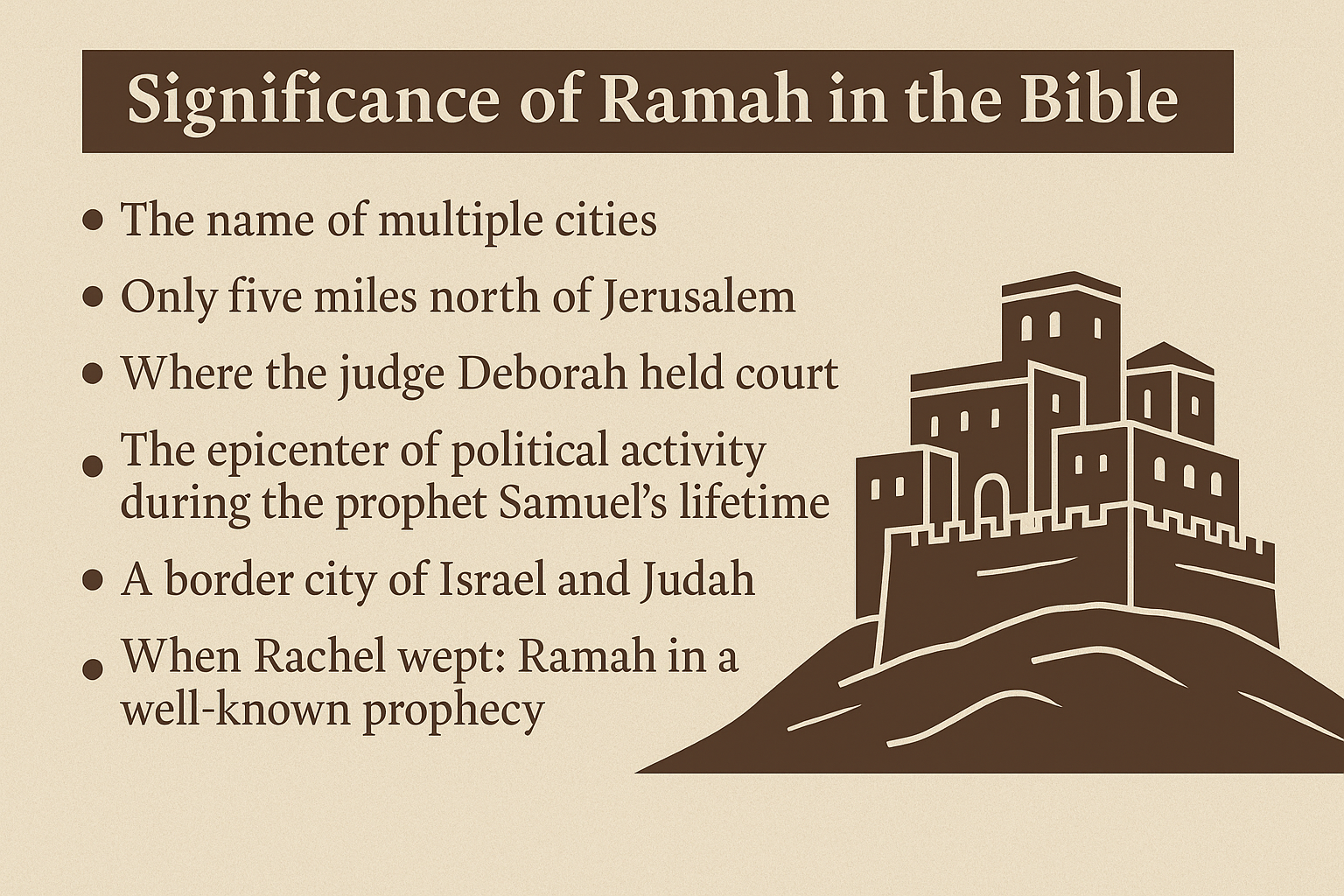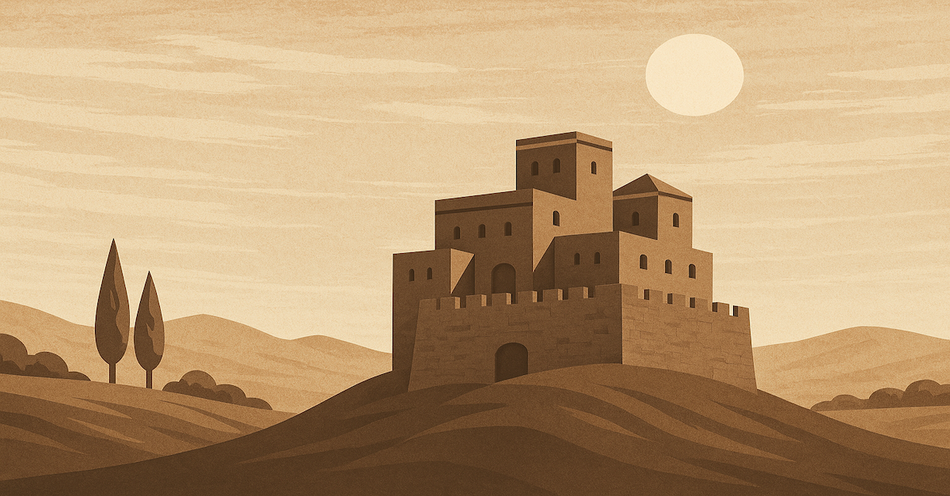In the Bible, Is Ramah a Person or a Place?
Note* This article contains a spoiler alert for The Chosen Season Four, Episode Three.
Maybe you’re familiar with the name “Ramah” from the popular series The Chosen. Ramah is a character introduced in Season One, Episode 5, when Jesus turns water to wine at the wedding in Cana.
Writer Dallas Jenkins depicts the Apostle Thomas as a caterer who works with Ramah, the beautiful daughter of his employer. From the first moments Ramah steps on screen and chooses, along with Thomas, to follow Jesus, she becomes an integral part of the cast, a perfect fit for the historical backdrop of The Chosen. She works alongside the other disciples, studies Scripture, and asks Jesus questions that you or I might ask him.
Her relationship to Thomas also blossoms. On one occasion, Thomas promises her father he will protect her. And then finally, Thomas asks Ramah’s father for Ramah’s hand in marriage. When Ramah’s father refuses, Jesus agrees to give her away and to officiate the marriage of Thomas and Ramah.
Then comes the moment in which a Roman guard demands Jesus’s disciples tell him Jesus’s location. Amidst the chaos, Ramah is killed.
Ramah’s death in the show has become a controversial topic among pastors and church leaders. Some argue that the death of a fictional person changes the narrative in Jesus’s story. “If Ramah’s storyline isn’t in Scripture, what other plot details of Jesus’ story are fictional?”
The creative liberties in this popular series could lead to confusion.
Scholars also debate whether Ramah’s death detracts from the true reasons for Thomas’s doubts about Jesus. While in the show, Thomas doubts Jesus’s sovereignty and goodness, in Scripture, Thomas doubts Jesus’s wisdom (John 11:16) and resurrection (John 20:25).
Yet, though Ramah’s character is fictional, Jenkins and the other writers of The Chosen use Ramah’s character to depict real concepts from Scripture, such as:
- Female disciples of Jesus (Mark 15:40, Matthew 28:8)
- Leaving family to follow Jesus (Matthew 10:34-39; 19:29, Mark 10:29)
- Jews plotting against Jesus (John 11:45-57)
- Losing life for Jesus (Matthew 10:39)
- An Old Testament prophecy (Matthew 2:18)
- The promise of tribulation (John 16:33)
- Thomas’s cynicism (John 11:16)
While the character Ramah is fictional, writers named her after a real place in Scripture. Oddly enough, despite the city of Ramah’s pivotal role in the Old Testament, the place is only mentioned one time in the New Testament (Matthew 2:18). Even the New Testament occurrence refers to an Old Testament prophecy.
What Is Ramah in the Bible?
Ramah in the Bible is a place of deep prophetic and historical meaning. Located in the territory of Benjamin, it was the home of the prophet Samuel and a site where God's judgment and comfort were both declared. Mentioned in Jeremiah 31:15 and echoed in Matthew 2:18, Ramah became symbolic of mourning and hope, especially in times of exile and restoration.
Ramah is also:
- The name of multiple cities
- Only five miles North of Jerusalem
- Where the judge Deborah held court
- The epicenter of political activity during the prophet Samuel’s lifetime
- A border city of Israel and Judah
- When Rachel wept: Ramah in a well-known prophecy
Let's look at each of these significant facts about Ramah in more detail.
1. The Name of Multiple Cities
Four Israelite tribes reference a city called Ramah—Simeon (Joshua 19), the southern-most territory, as well as Asher and Naphtali in the north. Asher and Naphtali shared a border and therefore may have referenced the same Ramah (Joshua 18:25; 19:8, 29, 36). The most renowned Ramah, however, is in Benjamin, located just north of Jerusalem.
2. Only Five Miles North of Jerusalem
Imagine a vertical line, spanning fifteen miles. Four cities, each five miles apart, span that line. North to South, they are: Bethel, Ramah, Jerusalem, and Bethlehem. Ramah means “high place,” and had an elevation of 2,500 feet, comparable to the height of Jerusalem. East-West and North-South trade routes passed in close proximity to Ramah.
3. Where the Judge Deborah Held Court
Judges 4 describes the prophet Deborah holding court between Bethel and Ramah. She summons the military commander Barak, and he meets with her in Ramah to draw battle plans against Jabin, king of Canaan.
4. The Epicenter of Political Activity during the Prophet Samuel’s Lifetime
The prophet Samuel was born to Elkanah and Hannah in Ramah, and he often returned to the city as an adult, eventually taking up residence there himself (1 Samuel 1-3). Elders of Israel visit Samuel in Ramah and ask him to anoint a king. It is there, in Ramah, where Samuel anoints Saul as Israel's first king (1 Samuel 8-10). Later, when Saul pursues David to kill him, David seeks refuge with Samuel in Ramah (1 Samuel 19:11-24).
5. A Border City of Israel and Judah
After King Solomon’s death, when the country divided into the two separate countries of Israel and Judah, Ramah was among pivotal border cities, along with Bethel, Mizpah, and Geba. Baasha, king of Israel, attacks Asa, king of Judah, and secures Ramah to cut off the people of Judah. In Ramah, Baasha begins building a fortress. When Asa defeats Baasha, he commands the men of Judah to bring Baasha’s building materials—timber and stone—to Mizpah and Geba, where Asa strengthens those two cities.
6. When Rachel Wept: Ramah in a Well-Known Prophecy
Sometimes when I read Scripture, I come across a seemingly important detail and wonder about its significance. Two weeks after my first miscarriage, I tore through the Bible in search of hope regarding infant loss. Instead, I heard mothers weeping, whose cries could be heard from Bethlehem to Ramah. Confusion yanked me out of grief and I asked, “Why Ramah? Where on earth is Ramah?” I wondered about the distance between the two cities because I wanted to know how far mothers’ cries carried.
As you may know, when Herod heard of a newborn Jewish king in Bethlehem, he attempted to kill Jesus by killing every boy two years old and younger. In his gospel, Matthew describes the event and parallels a prophecy from Jeremiah, who witnessed and experienced overwhelming grief in Ramah.

Where Does Scripture Mention Ramah?
As I dove deeper into my research, I started categorizing what I learned about Ramah into two categories: before Jeremiah and after Jeremiah.
Ramah Before Jeremiah:
Similarly to Hollywood Boulevard in California, Ramah was known by the Israelites for who had been there—the judge Deborah, the prophet Samuel, Israel’s elders, and kings Saul, David, Baasha, and Asa—as well as others. The judges, prophets, and kings represent three distinct time periods in Israel’s history, and Ramah plays a role in each Act.
Ramah After Jeremiah:
Then we come to King Zedekiah, the last king in Judah’s history, who holds the prophet Jeremiah prisoner in the palace courtyard. King Nebuchadnezzar of Babylon captures the royal family in Jerusalem and everyone at the palace, including Jeremiah, and marches them North toward Babylon.
Something interesting happens when they reach Ramah, just five miles North of Jerusalem. King Nebuchadnezzar takes special note of Jeremiah and releases him. Jeremiah and some of the poorer Israelite families are left behind. That day, in Ramah, Judah is torn in half when Jewish exiles are led to Babylon.
While weeping over Jerusalem, Jeremiah’s heart is overcome with a prophecy that layers his current reality with God’s promise of a hopeful future.
Ramah is within the tribe of Benjamin’s territory and Benjamin is the son of Rachel, hence “Rachel weeping for her children …because they are no more.”
This is why Jeremiah writes:
Thus says the Lord:
“A voice is heard in Ramah,
lamentation and bitter weeping.
Rachel is weeping for her children;
she refuses to be comforted for her children,
because they are no more.” Jeremiah 31:15
David captures the same despair when he weeps over Saul and Jonathan’s death:
“Daughters of Israel,
weep for Saul,
who clothed you in scarlet and finery,
who adorned your garments with ornaments of gold.
“How the mighty have fallen!
The weapons of war have perished!”
2 Samuel 1:24, 27
Rachel’s children are taken from home. It is also worth noting that Rachel is buried in Bethlehem, ten miles south of Ramah.
Therefore, Jeremiah speaks of Rachel weeping from her grave in Bethlehem about the exile in Ramah, where her descendants live. Matthew (Matthew 2:18) speaks of the massacre in Bethlehem, where Rachel’s resting place is.
Yet, there is hope. Jeremiah's prophecy alludes to a hope-filled future, despite the current despair.
“See, I will bring them from the land of the north
and gather them from the ends of the earth.
Among them will be the blind and the lame,
expectant mothers and women in labor;
a great throng will return.
“Hear the word of the Lord, O nations,
and declare it in the coastlands far away;
say, ‘He who scattered Israel will gather him,
and will keep him as a shepherd keeps his flock.’
For the Lord has ransomed Jacob
and has redeemed him from hands too strong for him.
They shall come and sing aloud on the height of Zion,
and they shall be radiant over the goodness of the Lord,
over the grain, the wine, and the oil,
and over the young of the flock and the herd;
their life shall be like a watered garden,
and they shall languish no more.
Then shall the young women rejoice in the dance,
and the young men and the old shall be merry.
I will turn their mourning into joy;
I will comfort them, and give them gladness for sorrow.
I will feast the soul of the priests with abundance,
and my people shall be satisfied with my goodness,
declares the Lord.
“There is hope for your future,
declares the Lord,
and your children shall come back to their own country.”
Jeremiah 31:8, 10-14, 17
Notice the contrast between the mother Rachel weeping and God’s promise. God’s portrait of the future includes expectant mothers, women in labor, young women dancing, and children returning home.
Matthew only quotes a single portion of Jeremiah’s prophecy:
“A voice is heard in Ramah,
lamentation and bitter weeping.
Rachel is weeping for her children;
she refuses to be comforted for her children,
because they are no more.” Jeremiah 31:15, Matthew 2:18
Yet, while Jeremiah alludes to hope, Matthew shows us the manifestation of hope. Not only did Hope escape to Egypt, God maneuvered Hope to safety before Herod even had a chance to enact his decree.
Why Ramah Still Speaks to Us Today
The holidays are nearly upon us. Thanksgiving and Christmas can be very difficult for those separated from loved ones by distance or death. Yet, just like for those in Ramah, there is hope. God shows us a hope on the horizon, embodied in the person of Jesus Christ. This promise is sketched all throughout Scripture—the Jewish exiles, Jesus returning to Zion after Herod’s death, Jesus’s story of the prodigal son. We are the children in exile, separated from our Father in heaven, and God promises that one day we will return home, into His loving arms. We will be reunited with our loved ones and will dwell with God forever.
Image created using AI technology and subsequently edited and reviewed by our editorial team.


.jpg)

